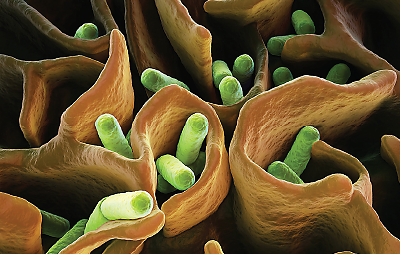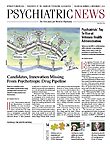Gut Bacteria Implicated In Eating Disorders
Intestinal bacteria may contribute to certain eating disorders, reports a new study in Translational Psychiatry.
Researchers at INSERM identified ClpB, a protein produced by E. coli and other intestinal flora, as the potential culprit. The immune system produces antibodies against ClpB when it is present, but these antibodies can also bind to melanotropin—the primary satiety hormone. When the antibodies bind to melanotropin, they affect its ability to regulate fullness.
As a test, mice were injected with E. coli in their gut; at first, these mice reduced their eating, but later the animals altered their habits and ate smaller meals, but ate more frequently than normal. This was not due simply to the introduction of new bacteria, as mice receiving an E. coli strain that did not produce ClpB did not differ from control mice in weight gain, food intake, or feeding pattern at any time.
The researchers also found that higher levels of anti-ClpB antibodies that also reacted to melanotropin were present in blood samples of people with anorexia nervosa, bulimia, and binge eating disorder, suggesting that melanotropin disruption is relevant in human feeding habits.
Tennoune N, Chan P, Breton J, et al. Bacterial ClpB heat-shock protein, an antigen-mimetic of the anorexigenic peptide α-MSH, at the origin of eating disorders.
Transl Psychiatry. 2014;4:e458.
Reducing Substance Use Reduces Risk of Aggression
People with both a serious mental illness and a substance abuse problem are at risk for increased aggression. Both conditions contribute to this risk, but according to an analysis of 278 patients who were admitted to an outpatient dual-diagnosis treatment program, reducing substance abuse may be more influential in reducing future violence.
Researchers followed the patients for six months and found that the level of participation in the dual-diagnosis program did correlate with reduced aggression. However, further analysis found that the severity of the patient’s psychiatric symptoms was not related to his or her aggression. Rather, substance use was the mediator; greater involvement in the program was associated with reduced substance use and lower aggression.
Study co-author Clara Bradizza, Ph.D., a researcher at the University at Buffalo Research Institute on Addictions, commented that the findings highlight the importance of reducing substance abuse among people with mental illness. “This not only improves the lives of affected individuals and their families, but also provides a safer environment for society as a whole,” she said.
The study findings were published in the Journal of Substance Abuse Treatment.
Zhuo Y, Bradizza C, Maisto S. The influence of treatment attendance on subsequent aggression among severely mentally ill substance abusers.
J Subst Abuse Treat. 2014;47(5):353-61.
Physical Activity Helps Purge Depression-Associated Chemical From Body
Physical exercise helps protect the body from stress-induced depression, though a new study in Cell suggests the mechanism is not what many people might think. Rather than boosting the production of pro-health compounds, exercise stimulates the production of an enzyme that breaks down a stress-related substance known as kynurenine.
Kynurenine is found at elevated levels in people with mental illnesses such as schizophrenia and depression, though the contributing role of kynurenine isn’t known.
Jorge Ruas, an investigator at Sweden’s Karolinska Institutet, and his team subjected two sets of mice to stressful stimuli like loud noises or flashing lights; after five weeks of stress, regular mice showed depressive symptoms, whereas mice genetically modified to have well-trained muscles remained normal.
These “muscle mice” had higher levels of an enzyme called KAT in their skeletal muscle, which converts kynurenine into kynurenic acid. Unlike kynurenine, kynurenic acid does not pass the blood-brain barrier and thus can be excreted from the body.
As Ruas explained, “In this context the muscle’s function is reminiscent of that of the kidney or liver.”
Agudelo L, Femenía T, Orhan F, et al. Skeletal muscle PGC-1α1 modulates kynurenine metabolism and mediates resilience to stress-induced depression.
Cell. 2014 Sep 25;159(1):33-45.
Study Highlights Potential Link Between Stress, Social Dysfunction
Stress frequently brings about emotional and cognitive issues such as irritability and forgetfulness. Researchers at the EPFL (the Swiss Federal Institute of Technology) Brain Mind Institute discovered a biological mechanism behind this connection, which involves some overeager cutting by an enzyme called MMP-9.
Chronic stress triggers a release of the chemical glutamate, which activates NMDA receptors on neurons. As published in Nature Communications, Carmen Sandi, Ph.D., and colleagues found that the NMDA receptors in turn activate MMP-9 (matrix metalloproteinase-9), an enzyme that chops up other proteins, in the brain’s hippocampus.
This MMP-9 proceeded to cleave nectin-3, an adhesion protein that keeps adjacent neurons close together so they can have an effective synaptic connection. The stress was, in effect, breaking synapses apart.
The process could be reversed, however, as researchers could restore the sociability of stressed rats through drugs that inhibited either MMP-9 or NMDA receptors.
“The identification of this mechanism is important because it suggests potential treatments for neuropsychiatric disorders related to chronic stress, particularly depression,” Sandi said.
Van der Kooij M, Fantin M, Rejmak E, et al. Role for MMP-9 in stress-induced downregulation of nectin-3 in hippocampal CA1 and associated behavioural alterations.
Nat Commun. 2014; 5:4995.
Early Progression to Intoxication Contributes To Heavy Drinking
Drinking at an early age is considered a leading risk factor for subsequent alcohol abuse, yet research in this area has produced inconsistent findings. A new study of high-school-age drinkers suggests that not only is the age when alcohol consumption began is relevant, but also how quickly a young drinker becomes intoxicated.
This analysis, published in Alcoholism: Clinical & Experimental Research, anonymously surveyed 295 teens about their drinking history and habits. The results showed that both age of drinking onset and the time between first drink and first intoxication (delay) were both determinants of future alcohol use in teens.
A short delay by itself did not significantly influence future binge drinking, but when considered in concert with age of onset, it was a strong predictor of risk—more so than age of onset alone.
As study author Meghan Morean, Ph.D., an assistant professor of psychology at Oberlin College, explained, “We would expect a teenager who had his first drink at age 14, and who got drunk at 15, to be a heavier drinker than a teenager who had his first drink at 14 and waited to get drunk until 18.”
Morean M, Kong G, Camenga D, et al. First drink to first drunk: age of onset and delay to intoxication are associated with adolescent alcohol use and binge drinking.
Alcohol Clin Exp Res. September 24, 2014. [Epub ahead of print]
Mini-Strokes May Increase Risk of PTSD
New research in the journal Stroke suggests that transient ischemic attacks (TIAs), also known as “mini-strokes,” may increase the risk of developing posttraumatic stress disorder (PTSD).
Researchers in Germany and Great Britain assessed and surveyed 108 people who had experienced a TIA, which is a short-term restriction of blood flow in the brain that does not cause permanent damage. They found that 29.6 percent of TIA patients had symptoms consistent with PTSD—about 10 times the prevalence of the general population in Germany. Many of the patients also reported decreased levels of mental and physical health.
The authors believe that while mini-strokes cause no permanent damage, fears of a subsequent larger stroke may lead to the onset of PTSD. The risk of PTSD following TIA also correlated with younger age and people who had poor coping behaviors in general.
They suggested that providing patients with better counseling about the realistic risks of future ischemic events along with more positive adaptive strategies could prove beneficial to TIA patients. ■
Kiphuth I, Utz K, Noble A, et al. Increased prevalence of posttraumatic stress disorder in patients after transient ischemic attack.
Stroke. October 2, 2014. [Epub ahead of print]

